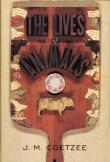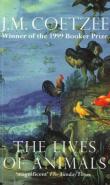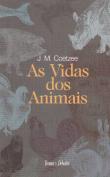AustLit
Latest Issues
AbstractHistoryArchive Description
'The idea of human cruelty to animals so consumes novelist Elizabeth Costello in her later years that she can no longer look another person in the eye: humans, especially meat-eating ones, seem to her to be conspirators in a crime of stupefying magnitude taking place on farms and in slaughterhouses, factories, and laboratories across the world. Here the internationally renowned writer J.M. Coetzee uses fiction to present a powerfully moving discussion of animal rights in all their complexity. He draws us into Elizabeth Costello's own sense of mortality, her compassion for animals, and her alienation from humans, even from her own family. In his fable, presented as a Tanner Lecture sponsored by the University Center for Human Values at Princeton University, Coetzee immerses us in a drama reflecting the real-life situation at hand: a writer delivering a lecture on an emotionally charged issue at a prestigious university. ' (Publication summary)
Adaptations
-
form
y
 The Lives of Animals
( dir. Alex Harvey
)
United Kingdom (UK)
:
British Broadcasting Corporation (BBC)
,
2002
8035810
2002
single work
film/TV
The Lives of Animals
( dir. Alex Harvey
)
United Kingdom (UK)
:
British Broadcasting Corporation (BBC)
,
2002
8035810
2002
single work
film/TV
'Based on the writings of Booker Prize winner JM Coetzee, this powerful dramatisation is directed by Alexander Harvey. It follows Elizabeth Costello , to whom the idea of human cruelty to animals is so abhorrent that she can no longer look another person in the eye. Her compassion leads her to believe that humans - and especially meat-eaters - are conspiring in a crime on an appalling scale.'
Source:
[Television guide], Radio Times, 18 July 2002, p.103.
Notes
-
Wikipedia entry : http://en.wikipedia.org/wiki/The_Lives_of_Animals
Publication Details of Only Known VersionEarliest 2 Known Versions of
Works about this Work
-
Who Let the Zoologists Back in? Creative Discourse in the Ph.D. in Creative Writing
2022
single work
criticism
— Appears in: New Writing , vol. 19 no. 3 2022; (p. 276-286)'In Australian and British universities, creative discourse is often devalued as a research activity in favour of hard scientific paradigms, and even though the artefact is the primary research activity for the Ph.D. in Creative Writing, it is relegated to a secondary way of knowing, which needs to be translated into more ‘respectable' academic discourse in order to be recognised as legitimate or ‘real’ research. This paper re–affirms the creative artefact as primary research activity, an end in itself, not a means to another, and asserts itself in the academic arena as its own discourse which is not accountable to any other discourse for its legitimacy. It needs no exegetical justification, sets its own parameters, and needs to be evaluated as a literary work using literary tools to measure its research value. This paper also examines the distinction made between Creative Writing and Creative Writing Studies in defining how an artefact creates knowledge and offers a series of philosophical experiments to examine if and how a creative artefact can be considered research, and suggests that the exegesis, rather than being the main conduit of research, is a shorthand device to demonstrate the competencies of the artefact as research.'(Publication abstract)
-
Bidding the Animal Àdieu : Grace in J.M. Coetzee’s The Lives of Animals and Disgrace
2017
single work
criticism
— Appears in: Literature and Theology , June vol. 31 no. 2 2017; (p. 231–245)'J.M. Coetzee’s focus on animals in Disgrace and The Lives of Animals forces his readers to question the contours of their ethical frameworks, including the distinction between human and animal realms and whether animals must necessarily compete for imaginative space with human beings. I argue that Coetzee asks us to envision what effect human and animal interactions can have in the midst of trauma, and offers the idea of grace as a surprising, if tentative, answer.' (Publication abstract)
-
Saying and the Interruption of the Said : Ethical Considerations in and on J.M. Coetzee’s The Lives of Animals
2017
single work
criticism
— Appears in: Journal of Literary Studies , vol. 33 no. 3 2017; (p. 97-115)'Using J.M. Coetzee's The Lives of Animals (Coetzee 1999) as a basis, our article compares the straightforward ethical reading of literature as an unproblematic means for creating reader sympathy (as exemplified by the work of Martha Nussbaum), with an approach based on Emmanuel Levinas's sense of otherness. For Levinas, reading involves an awareness of otherness that does not control or circumscribe the other, but that encourages a continual unfolding of its possibilities. In this connection, he distinguishes between the “said”, that which is complete, written down once and for all, and the “saying”, that which can “interrupt” our readerly assumptions by revealing the presence of otherness. The sense of otherness, because so fundamental to our interaction with the world, needs to be respected, our ethical obligation or responsibility towards it acknowledged. We believe The Lives of Animals fosters such a sense of obligation. It both thematises moral concerns and helps enact moral understanding, unlike a straightforward sympathetic approach, which depends on exclusionary opposition at the expense of a more knowing engagement with otherness.' (Introduction)
-
y
 Sympathy for the Animal(ized) Other in Selected Works of J. M. Coetzee
Hong Kong
:
2015
8424922
2015
single work
thesis
Sympathy for the Animal(ized) Other in Selected Works of J. M. Coetzee
Hong Kong
:
2015
8424922
2015
single work
thesis
'Sympathy, understood to be the capacity to suffer with the other, has long been regarded as one of the major vehicles to inspire an ethical communion. By minimizing differences through identification, sympathy helps us resonate with other beings and to exist in relation to them. This thesis examines the ethical endeavors on the vexed question of sympathy in four works by J. M. Coetzee - - The Lives of Animals (1999), Disgrace (1999), Elizabeth Costello (2003) and Slow Man (2005), all of which manifest Coetzee's notable interest in a fully-engaged sympathetic imagination into depraved and deprived human or nonhuman subjects. ' (Thesis summary)
-
Mirror Neurons and Literature : Empathy and the Sympathetic Imagination in the Fiction of J.M. Coetzee
2014
single work
— Appears in: MediaTropes , vol. 4 no. 2 2014; (p. 98-113) 'In the two essays “The Philosophers and the Animals” and “The Poets and the Animals” (in The Lives of Animals, 1999) J.M. Coetzee lets Elizabeth Costello urge us to use our sympathetic imagination in order to access the experience of others—in particular, animals—and engage with them empathetically. Coetzee’s fiction illustrates how the use of the sympathetic imagination might evoke empathy in the reader. Narrative structure and the character’s mode of introspection engage the reader’s empathy through an ambivalent process of distancing and approximation, as Fritz Breithaupt puts forward in his narrative theory of empathy (Kulturen der Empathie, 2009). The sympathetic imagination and the complementary notion of embodiment feature prominently in Coetzee’s fictional discourse and resonate with neuroscience’s research on mirror neurons and their relation to empathy.' (Publication abstract)
-
What Does It Mean to Teach The Lives of Animals or Disgrace?
2014
single work
criticism
— Appears in: Approaches to Teaching Coetzee's Disgrace and Other Works 2014; (p. 43-48) -
Pedagogies of Discomfort : Teaching Coetzee’s The Lives of Animals
2014
single work
criticism
— Appears in: Approaches to Teaching Coetzee's Disgrace and Other Works 2014; (p. 139-145) -
Teaching Coetzee’s The Lives of Animals in the First-Year Composition Classroom
2014
single work
criticism
— Appears in: Approaches to Teaching Coetzee's Disgrace and Other Works 2014; (p. 174-179) -
To Live : Exploring the Meshwork of Being in Aristotle, Agamben, Walcott, Hughes, and Coetzee
2014
single work
criticism
— Appears in: ISLE : Interdisciplinary Studies in Literature and Environment , Spring vol. 21 no. 2 2014; (p. 315-336) 'The aim of this paper will be to explore the insidious moves by which human discourse transforms the nonhuman world from an existing alterity to a dead object. The objective will then be to trace paths by which we can potentially make space again for the oikos/eco, the home, to exist. As such, it is an objective that can be identified with a multiplicity of discursive formations—literature, philosophy, anthropology—all of which are threads that intertwine in an orientation that must needs also be political since it is openly conducted with an ecocritical stance (though not a predetermined agenda). The ecocritical methodology I adopt is ultimately premised on the comparative principle of combination or contamination of discourses and against their separation into strict, “pure” forms. In the same vein, this reflects the understanding of the world implied by Tim Ingold's term “meshwork,” as a more accurate description of the “entangled lines of life, growth, movement” (Ingold 63), rather than the commonly used term “network,” which would imply discrete, “interacting entities” (Ingold 63). These paths to be then traced are really a form of relation to the earth as world expressed in poetic and philosophical language; such a relationality is first and foremost a way of imagining and experiencing being that decenters the human while relying nonetheless on a human form of expression for its achievement...' (Publication summary) -
“Animal Tracks in the Margin”: Tracing the Absent Referent in Marian Engel’s Bear and J.M. Coetzee’s The Lives of Animals
2014
single work
criticism
— Appears in: Ariel , vol. 45 no. 3 2014;'This paper considers Carol Adams' notion of the absent referent in Engel's Bear and Coetzee's The Lives of Animals. I argue that both texts call for altered notions of reading and criticism that attempt to write the evasive presence of animals within textuality. Engel and Coetzee use different techniques to at once point to the impossibility of textual presence, in Adams' sense, while also stressing the necessity of striving for a form of presence that represents animals beyond the logic of the absent referent.' (Publication abstract)





